

Falklands Herbarium. Ekman Herbarium, Haiti. This herbarium, founded in 1924, houses an important collection of specimens collected by Erik L.
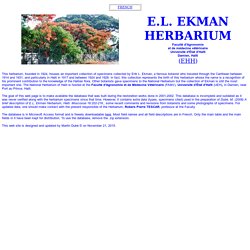
Ekman, a famous botanist who traveled through the Carribean between 1914 and 1931, and particularly in Haiti in 1917 and between 1924 and 1928. In fact, this collection represents the birth of this herbarium whose the name is a recognition of his prominent contribution to the knowledge of the Haitian flora. Other botanists gave specimens to the National Herbarium but the collection of Ekman is still the most important one. The National Herbarium of Haiti is hosted at the Faculté d'Agronomie et de Médecine Vétérinaire (FAMV), Université d'État d'Haïti (UEH), in Damien, near Port au Prince, Haiti. The goal of this web page is to make available the database that was built during the restoration works done in 2001-2002. The database is in Microsoft Access format and is freeely downloadable here.
Instituto de Botánica Darwinion. Argentina: la botánica en Mendoza - Los herbarios, o sea, colecciones de muestras de plantas que mayormente se conservan secas, son utilizados por especialistas para estudios agronómicos, ambientales, polínicos, dendrocronológicos, paisajísticos, farmacopéicos, de biodiversidad, e incluso lingüísticos.

La colección del IADIZA es la mayor del oeste argentino y posiblemente la más activa de la zona por la cantidad de visitantes y el fluido intercambio con otras instituciones. En lo que a herbarios se refiere, Mendoza parece ser pionera. A principios del siglo XIX, el escocés John Gillies (1792-1834) realizó importantes colecciones en las cuales se describieron unas 200 especies desconocidas para la ciencia hasta ese momento. Biodiversity portal launched. After twelve long months of preparations, the Caribbean Biodiversity Information Portal has finally been launched.
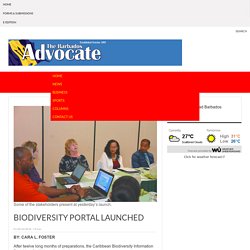
Speaking at the official launching ceremony, which took place at The Savannah Hotel yesterday morning, Assistant Curator of the Natural History Department at the Barbados Museum and Historical Society, Kerron Hamblin, revealed that the project was a year long regional project among the Museum, the University of the West Indies Zoological Museum at the St. Augustine Campus and the National Zoological Collection of Suriname. “Currently the portal is just populated with information from the three partner institutions, but naturally, because the natural history collection at the Barbados museum is quite small, there are some gaps in the specimen record for Barbados. Herbarium visit to La Paz (LPB) One important task for specialists in a particular plant group, in my case nettles, is to visit national or regional collections and not just rely on the collections of our own institutes, no matter how good they are.
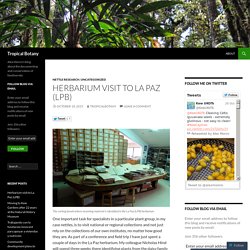
As part of a conference and field trip I have just spent a couple of days in the La Paz herbarium. My colleague Nicholas Hind will spend three weeks there identifying plants from the daisy family (Compositae) and running an identification course. There were 92 boxes of unidentified Compositae waiting for him when we arrived! This herbarium was founded by German botanist Stephan Beck in 1984 and currently houses over 400,000 herbarium specimens.
The reason why such visits are important both for the specialist but also for the herbarium are that although there is an active inter-herbarium loan system for plants it relies on material being accessioned, mounted and identified. Like this: Like Loading... Brazilian Plants in Sweden. Herbarium collection of the Rio de Janeiro Botanical Garden (RB), Brazil. Catholic University of Paraná (HUCP), Curitiba, Southern Brazil. The classification of algae, fungi and higher taxa are according to Adl, et al. [19], Angiosperm follow the classification proposed by APG-IV [20], and Pteridophyte follow PPG I [21].
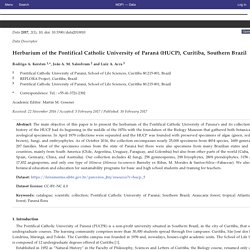
Fungi (42/14) ○Opistokonta. Musgos y hepáticas del salto de Conchalí, 1878, Santiago, Chile - Museo Nacional de Historia Natural. Fuente: Museo Nacional de Historia Natural El Herbario SGO (Código del Herbario del MNHN a nivel internacional referido a su ubicación en la ciudad de Santiago de Chile) del Museo Nacional de Historia Natural alberga interesantes ejemplares de flora no vascular recolectados en la ciudad de Santiago a mediados del siglo XIX.

Al respecto, durante la revisión de material histórico depositado específicamente en el herbario de musgos chilenos, hallamos una muestra que menciona como localidad de recolección “Salto de Conchalí, 20-IV-1878” (Fotografía 1 y 2). Este desconocido pero interesante nombre nos lleva inevitablemente a vincularlo con la actual comuna de Conchalí, en el sector norte de la ciudad de Santiago, donde confluyen las comunas de Huechuraba y Recoleta.
En esta última se ubica el antiguo barrio El Salto, todas localidades cercanas a los cordones montañosos que se extienden desde el cerro Manquehue a N-E. Columbia digitized 600,000 specimens. Jardín Botánico de Bogotá. Natural History Museum of Jamaica teams... - Natural History Museum of Jamaica. The Interdisciplinary Documentation of the Flora of La Ventosa, Mexico. Mexico: Colecciones Biológicas. Portal de Datos Abiertos UNAM Colecciones Universitarias Acceso a curadores Cerrar sesión Colecciones Biológicas en: Nombres comunes.
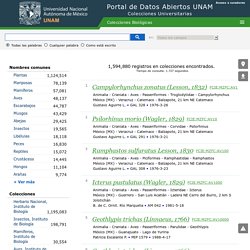
Falklands Herbarium. Herbarium Truxillense Peru. Today we spent the day databasing specimens in the local Trujillo herbarium; all herbaria have 1-4 letter acronyms, standard codes so we all know what collection we are talking about – the one for the herbarium in Trujillo is HUT.

It is a small collection and has been built up over the last few decades by a series of local botanists – the one I knew the best was Abundio Sagástegui, who sadly died a few years ago. The collection is rich in material from this area of Peru – and has a lot of gems. For example – I described Solanum clivorum in 1992 and have only seen a few specimens. Here at HUT we saw eight new ones, thus expanding our knowledge about this species’ distribution hugely!
Space is at a premium at HUT – Tiina and my computer tried to share the desk – Tiina eventually won! Maria used the other computer to database specimens, balancing it all on a stool….. Trujillo is a beautiful city, with old colonial architecture and wonderfully painted buildings. National Herbarium of Trinidad and Tobago. Digitalizando el Patrimonio Natural del Uruguay. Herbarium collections: Venezuela's botanic heritage in jeopardy : Nature : Nature Research.